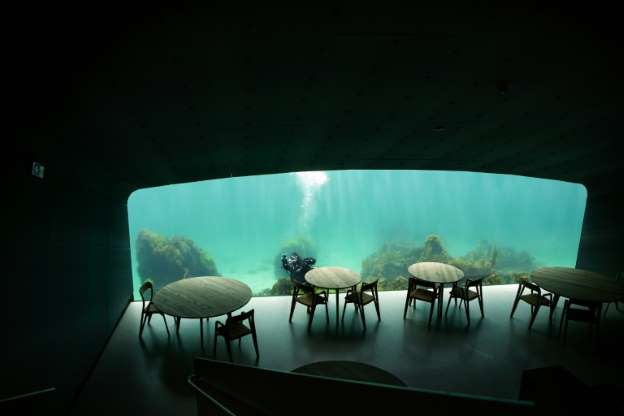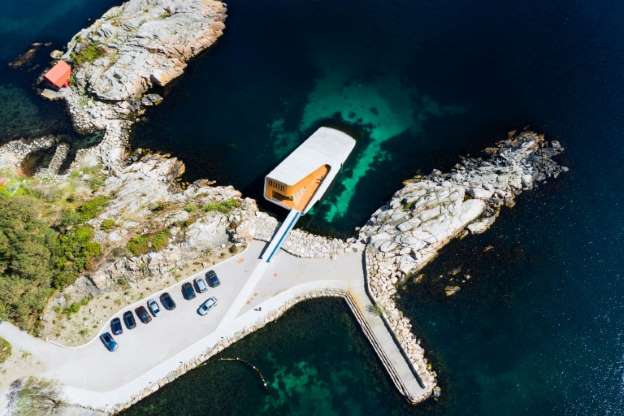For chef and diners alike, each meal beneath the waves at Europe’s first underwater restaurant is a thing of wonder.
“We have this small window next to the kitchen and every time some special kind of fish comes by, I always start thinking about how it would taste,” chef Nicolai Ellitsgaard said.

The aptly named new restaurant Under opened a few weeks ago in Lindesnes on Norway’s southern tip.
It serves up Poseidon’s delicacies in an architectural showpiece that stretches down five meters (15 feet) underwater, offering a unique closeup of ocean life.
From the outside, the giant concrete monolith juts out from the craggy shoreline, while its other end tips down into the North Sea.

Customers enter the restaurant onshore through a wood-panelled passage and descend down a long, oak staircase into a dimly lit dining room. A gigantic plexiglass underwater window takes center stage.
The 36-square meter (398-square foot) window known as a “like a sunken periscope” in the words of its designers offers a panoramic view of the ever changing live aquatic show.
In Norwegian, “under” means it is under, like submerged, underwater, and it also means a sense of wonder,” said Stig Ubostad, who co-owns the eatery with his brother, Gaute.
“It is without doubt the largest one in the world and the only one in Europe.”
Nature’s never disappointing
There are no clown fish or sharks, like at other underwater restaurants in more tropical locations such as the Maldives or Dubai.
Rather it is in a simple but no less spectacular forest of kelp that cod, pollock and wrasse swim past depending on the season, with occasional visits from its predators, seals and large sea ducks.
“It is an area on the southern tip where the brackish water from the east meets the salty water from the Atlantic, so the richness of the species is very high,” said Trond Rafoss, a marine biologist involved in the project.
In addition to its distinctive architecture and fine dining, Under wants to shine a spotlight on environmental issues.
The international waiting staff are trained to provide guests with information about the aquatic show they are watching.
“The guests are on an adventure, they are exploring the nature themselves, because this is not an aquarium. The fish might look at us as an aquarium because what’s happening outside here is under natural control,” Rafoss said. “You will never be disappointed, nature is never disappointing.”
Algae dessert
The restaurant is a 34-meter monolith designed by Norwegian firm Snohetta, known for its celebrated buildings such as the Oslo Opera and the 9/11 Memorial Pavilion in New York.
It can serve up to 40 diners during its one sitting a day, five nights a week.
In the kitchen, Danish chef Nicolai Ellitsgaard and his staff let their imaginations run wild in creating seasonal menus based primarily on what the sea has to offer, including a dessert composed of five different types of algae collected from a nearby shore.
“We try to use things that are in the area, and also use things that nobody else is really using,” Ellitsgaard said.
The restaurant however, is probably not for everyone’s budget.
The tasting menu, consisting of 16 to 18 dishes, costs $258 (about P13,000) per person and double its price when wine is included.
Magnificent light
Under is nonetheless fully booked for the next six months.
“The wonder is when you come here from the surface and you get into this magnificent light,” said Dag Jacobsen, a 59-year-old professor, who dined there with his wife and another couple.
“You see this kind of underwater light, the greenish, bluish water and all the interior here is also quite tuned to the sea as well, so you get a feeling of just diving into the sea,” Jacobsen stated.
“It is impossible to differentiate between the senses, your taste, sight, sound, everything is connected so it influences the way we experience the food,” he added, admitting he was “a bit skeptical” at first but was ultimately sold on the concept.
For those who might worry about a catastrophe befalling the underwater structure, the owner says they can rest assured.
The 26-centimeter (10-inch) thick plexiglass window is designed to withstand storms, and the entire structure, with its thick concrete walls, is built to resist pressure and shocks from the rugged sea conditions.
“We have been through so many consultants I think it’s safer than anything else,” Ubostad said. HM/JB
RELATED STORIES:
LOOK: Pinoy finds replica of a famous Filipino fast food restaurant in China
My kind of mix-up: $5,760 bottle of wine served by mistake

